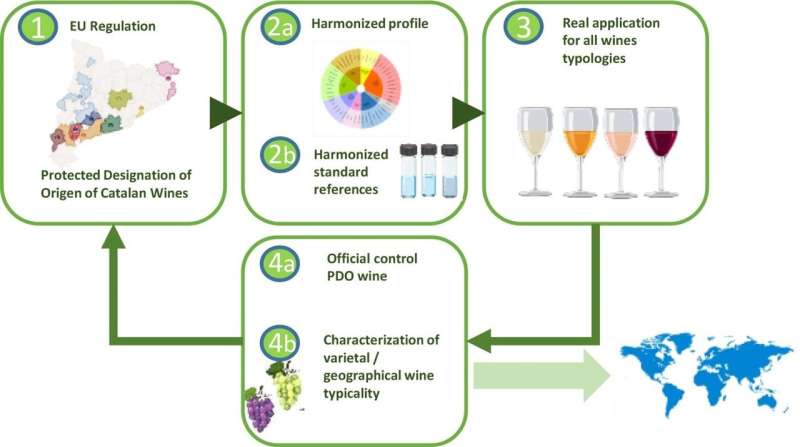This article has been reviewed according to Science X's editorial process and policies. Editors have highlighted the following attributes while ensuring the content's credibility:
fact-checked
trusted source
proofread
Researchers develop standard methodology for the sensory analysis of wine

Research involving the University of the Basque Country has resulted in a methodology to reliably and objectively analyze the sensory characteristics of wine. This is a standard tool that uses a single methodology to analyze the gustatory, olfactory and visual properties of different types of wine from the 11 Catalan designations of origin, and which can easily be applied to other designations of origin.
The study is published in the journal Food Research International.
For a wine to be awarded the Protected Designation of Origin (PDO) certification, it has to meet certain requirements (e.g., geographical, production, physico-chemical and sensory, etc.). The European regulation establishing these conditions was renewed in 2013, and since then the sensory characteristics of each type of wine produced in a PDO must be explicitly stated in the specifications.
The incorporation of this regulatory requirement entailed the need to set up laboratories and methods that would allow reliable sensory analysis of the gustatory, olfactory and visual characteristics of wines to be made, so that they could be verified by the corresponding competent body.
Given that sensory characteristics are perceived through the senses, one of the challenges facing the industry was to make the methods of analysis as objective as possible. And what was of interest at the same time was that a method did not have to be developed for each type of wine. In other words, that there should be a standard tool that could be used to evaluate different wine products. At that time it did not exist and, even today, no internationally harmonized method is used, unlike other products with designation of origin, such as virgin olive oil, for example.
In this context, in collaboration with the Catalan Institute of Vines and Wines (INCAVI) and the Institute of Agrifood Research and Technology (IRTA), the University of the Basque Country (UPV/EHU) has made a major contribution: it has developed a standard methodology for the sensory analysis of wine from the 11 Catalan designations of origin.
When the project was launched in 2016, there was only one sensory analysis method in Spain. It had been developed by the Laboratory of Sensorial Analysis of the University of the Basque Country (LASEHU) to analyze two specific types of wine: unoaked red wine from the Rioja Alavesa region and white Txakoli.
"We had 37 types of wine grouped into 11 PDOs. So coming up with a model for each of them was not feasible; so we decided to propose a different strategy that was less specific to a particular type of wine," explained Anna Gomis-Bellmunt, one of the authors of the study.
The methodology they developed includes a validated protocol for selecting the tasters to form the evaluation panel. The research team also managed to select and reach consensus on the descriptive profile in accordance with the specifications of the 11 Catalan PDOs for the different types of wine.
Anna Gomis stressed that, among other things, they defined some imprecise terms commonly used in the sector. "Some specifications included hedonic terms, such as joyful, elegant, frank, kind.... You can't measure the kindness or joy of a wine." To put an end to the ambiguity, they specified that for a wine to be joyful, for example, it must have a specific acidity and citrus, floral and aromatic herb notes.
Step by step, a methodology for the olfactory, gustatory and visual evaluation of wine under controlled and reproducible conditions was specified and agreed upon. And references were also developed and validated for the attributes that make up the descriptive profile. In other words, if among the olfactory characteristics, one of the attributes that some wines must have is the aroma of cherry, an aroma reference was created to facilitate the training of tasters and thus guarantee the correct functioning of the panel of tasters. Finally, a quick and efficient method was specified and validated to check that the panel of tasters was functioning correctly.
A methodology with multiple applications
In addition to meeting the specific objective for which it was created, in other words, that the research should come up with an objective, reliable method for the sensory analysis of the 11 Catalan designations of origin, a tool that can easily be applied to other PDOs was developed. Moreover, it is already being used for a variety of purposes that were not envisaged. "We are seeing that it is a very powerful tool for the producers themselves in terms of innovation or their own monitoring, or for scientific research," said Gomis-Bellmunt.
The work can also contribute towards facilitating the creation of an internationally harmonized method. This is something that the researcher regards as important, given that "it would allow sensory analysis laboratories to speak the same language."
More information: Anna Gomis-Bellmunt et al, Sensory evaluation of Protected Designation of origin Wines: Development of olfactive descriptive profile and references, Food Research International (2023). DOI: 10.1016/j.foodres.2023.113828
Provided by University of the Basque Country

















